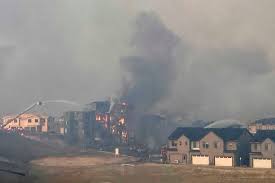When indications of a nearby grass fire swiftly morphed into a concerned pre-evacuation notice and then an order to leave immediately, Mike Guanella and his family were resting at their Colorado home, looking forward to a belated family Christmas later Thursday.
Wildfires fuelled by winds gusting up to 105 mph (169 kph) devoured parts of two communities, destroying an estimated 580 homes, a hotel, and a retail center, forcing tens of thousands of inhabitants from their homes west of Denver.
Guanella and his wife, their three children, and three dogs were staying at a friend’s house in Denver, hoping their house was still standing, instead of opening Christmas presents at home in the city of Superior, as they had intended.
“We’re hoping those presents are still under the tree right now,” Guanella remarked.
At least one first responder and six others were hurt in the flames that broke out early Thursday morning, unusually late in the year and following an exceptionally dry fall and a winter with little snow so far. Due to the ferocity of the fires that quickly raced over the region, Boulder County Sheriff Joe Pelle acknowledged that more injuries and deaths could occur.
“This is a fire we can’t battle head-on,” Pelle explained. “We really had deputy sheriffs and firefighters in locations that had to pull out due to overcrowding,” he continued.
Officials were watching how the winds and fires reacted as darkness fell to see when teams would be allowed to enter and assess the damage and look for any victims.
The cities of Louisville and Superior which are roughly 20 miles (32 kilometers) northwest of Denver and have a combined population of 34,000 people were ordered to evacuate earlier in the day. A section of U.S. Highway 36 in the area was also closed.
The surrounding towns are densely packed with moderate and upper-middle-class subdivisions, all of which are flanked by retail malls, parks, and schools. Between Denver and Boulder, a foothills college town home to the University of Colorado, is the region.
Residents fled in a somewhat quiet and orderly manner, but as people attempted to flee, the winding lanes of the subdivisions quickly became jammed. It may take up to 45 minutes for a car to travel half a mile (less than a kilometer).
As wind gusts drove the fire to jump and spread, small fires appeared in unexpected locations — on the grass in a median or in a dumpster in the midst of a parking lot. As emergency sirens blared nearby, the skies turned from clear to smoky and back again due to shifting winds.
Winds blasting through barren trees in the parking lot, surrounded by gloomy skies, a hazy sun, and little fires spread across the ground, according to a video shot by a bystander outside a Superior Costco store.
Leah Angstman and her husband experienced a similar sky on their journey back to Louisville from Denver International Airport following a holiday trip. Angstman recalls leaving the brilliant blue sky and entering clouds of brown and yellow smoke as they sat on the bus heading toward Boulder.
“The bus was rocking so fiercely that I believed it was going to tip,” she claimed.
Because of the low visibility, the bus had to pull over and wait for a half-hour for a regional transport authority van to take them to a highway turnaround.
“The sky was a dark, dark brown, and the dirt was blowing across the walkway in swirls like snakes,” she explained.
With his wife and parents, Vignesh Kasinath, an assistant professor of biology at the University of Colorado, evacuated from a Superior community. Kasinath said the family was both overwhelmed and anxious as a result of the quick evacuation warning and the confusion as they attempted to flee.
“I only found out about it because I’m on Twitter,” Kasinath said, adding that he had not received an official evacuation notice from officials.
The first fire broke out just before 10:30 a.m., according to Pelle, and was “attacked quite swiftly, lay down later in the day, and is presently being watched,” with no structures lost.
A second flame broke out shortly after 11 a.m. and “ballooned and expanded swiftly east,” according to Pelle. The fire is 2.5 square miles in size (6.5 square kilometers).
Downed power wires triggered some of the fires that erupted in the neighborhood on Thursday.
Gov. Jared Polis declared a state of emergency in response to the fires, allowing the state to access disaster relief funding.
The Front Range of Colorado, where the majority of the state’s population lives, had an exceptionally dry and warm fall, and the winter has been generally dry so far. Before a little storm on Dec. 10, Denver set a record for the longest period of time without snow. It hasn’t snowed since; however, the region is expecting snow on Friday.
Climate warming, according to scientists, is causing more intense weather and more frequent and destructive wildfires. In the United States West, a severe drought and heatwaves have made fighting wildfires more difficult.
90% of Boulder County is experiencing severe or exceptional drought, with no significant rainfall since mid-summer.
“With any snow on the ground, this would not have transpired in the extent that it did,” said Keith Musselman, a snow hydrologist who was at home when the fires broke out not far away on Thursday.
Following a dry summer, Musselman said this extreme fire risk is expected in September and October, but the absence of precipitation this late in the season is exceptional.
According to the National Weather Service, up to a foot of snow might fall in Boulder tomorrow, providing significant relief, according to Musselman.
Guanella said he heard from a firefighter friend on Thursday night that his family’s home was still standing. Now all he has to do is wait to see if that stays true.
“You’re just waiting to hear if your favorite restaurant is still open if your children’s schools are still open,” Guanella explained. “All you have to do now is wait for some clarification, which should come tomorrow.”

















